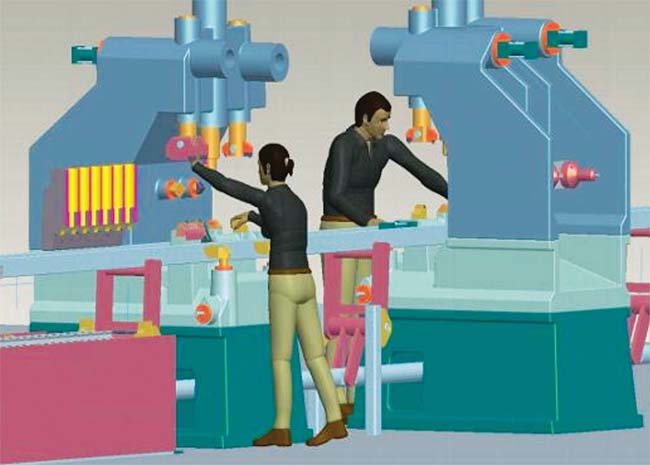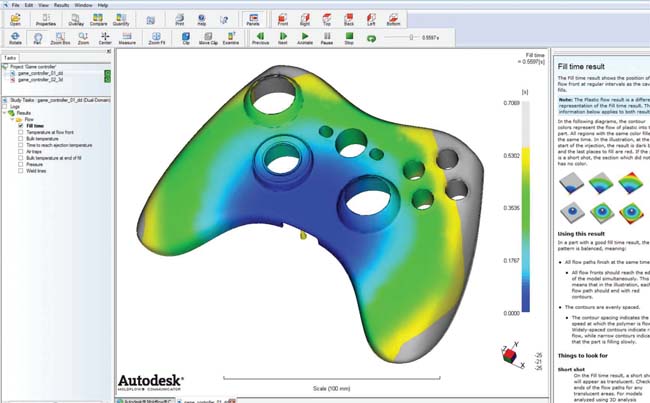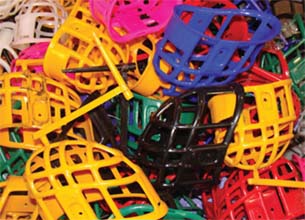Keeping MIME at Forefront of Design
Designing for minimum impact and maximum effect is as practical and cost-efficient as it is the environmentally responsible way to go.
Latest News
May 1, 2010
By Mike Hudspeth
Efficiency and simplicity are keys to successful design. I remind myself of that by adhering to the MIME principle—that’s design that results in minimum impact for maximum effect. MIME is a way of getting the most bang for your buck while at the same time keeping your influence as low-key as possible. It’s about doing more with less.
 Simulation allows you to build and test your designs without wasting anything but time and hard disk real estate. PTC even has a digital Manikin to test the ergonomics of large assemblies. |
Minimal Impact and Responsibility
Regardless of where you stand on the global warming debate, there’s no denying that everything we do has an impact on our surroundings. Yet MIME is more a practical approach to responsible design than an attempt to simply go green. The ultimate goal of MIME is to decrease expenses and increase profits by conserving resources and energy while at the same time minimizing any impacts on the natural environment.
The fact that green products sell is a supplemental gain to MIME design. “Going green” means finding a way to get the most out of what you have on hand without depleting supplies and making it necessary to go look somewhere else for more. It means using more sustainable products and materials that can be reused or re-grown. It means being more self-sufficient.
MIME Methods
Say you are asked to design a tube. You’ve heard the old saw that when you have a hammer everything looks like a nail. Well, if you are used to designing injection-molded parts, you might be tempted to just apply that process to the tube. Yes, you could get hundreds of great parts. But you’d have to design a new tool and it would cost you. And your lead-time would be measured in weeks, perhaps months. In contrast, an extrusion die is a tiny fraction of the cost of an injection mold. And lead times for extrusion dies can be as brief as days.
 With mold analysis you can see how your material will flow within your injection mold. You can find out the flow front temperature, how your parts will cool, even where your knit lines and gates will be well before you cut any tool metal. |
Aside from the tool there are raw materials to consider. For an injection mold you would most likely need to add in runners and sprues, both of which involve material waste and thus a higher per-piece expense. Machining is almost always going to give you more accurate parts, but the time and effort it takes to get them is costly. With an injection-molded part you get a more robust product because of their internal flow lines and counts in the hundreds of thousands—and fast.
Don’t forget packaging. Will a folded cardboard box make more sense than vacuum-formed foam? McDonald’s took a lot of grief for their Styrofoam containers years ago. They switched over to cardboard and their image improved. It certainly made marketing sense. MIME would tell us that we must know more about the available processes to select the one that offers the greatest ROI.
 With injection molding you can produce huge numbers of parts very quickly. But be very careful not to create too much scrap in the form of sprues and runners. |
Implementation and Tools
There are two good ways to implement MIME for any project you are working on. Both are part of designing for manufacturability (DFM). That means designing things that are easy to make. Acquire and read everything you can about designing for assembly (DFA) and designing for disassembly (DFD). With these you can minimize the materials it takes to create your parts, the man-hours to put them together, and the energy to recycle them. These are some of the best things you can do for your products and your company. And they are 100 percent MIME.
Chances are you’re already using the tools that will help with your MIME implementation. Most state-of-the-art 3D MCAD programs offer different kinds of analysis packages. This is a very MIME thing. FEA—even the stripped-down versions that come free with most software—can help you design stronger and more reliable parts. That’s good for business. With fewer fragile or broken parts going out, there is less material waste and happier customers. (Planned obsolescence is not an aspect of MIME.)
We now have enough computing power on our desktops to enable us to see how our designs will work in the real world. We can test them in many ways: forces applied, parts assembled, maintenance performed, etc. There are even software packages that can simulate whether a worker can reach a tool up on a shelf.
Tips for Applying MIME to Your Projects Think about the environmental impact of producing your product. Production byproducts can have an impact long after their useful life.
—MH |
Mold-analysis software is another product that falls into the good MIME camp. One of the most popular is MoldFlow from Autodesk. MoldFlow will help you find the optimum molding characteristics for your parts. You can simulate where knit lines will be (any time you have a through hole you’re going to have one), where you are likely to get trapped gases (and thus where you need vents), even where you can expect short shots. All you have to do is build your model, establish where your gate is (and perhaps how many) and the program takes care of the rest.
Computer aided machining (CAM) software is another MIME-friendly product. It reduces scrap costs by basing the toolpaths directly on your 3D model. There is generally no human error (like misreading a blueprint or even typos actually ON the blueprint). And repeatability is all but ensured.
Last but certainly not least are rapid prototyping (RP) tools. Yes, there are costs involved with any kind of prototype, and RP technology keeps them under control. You get your parts sometimes within hours, and there is no tooling scrap (depending on the process you use).
Earth’s a Closed System
I know that most of us don’t make the decisions about which projects we work on. Management and marketing make decisions that designers have to deal with. But we each can design and act as responsibly as we choose. And in that way, we can effect change and make a difference in our world one decision at a time. Ultimately MIME is about designing sustainably so we don’t use up all the planet’s resources.
Earth is a closed system. There may come a time when we have exhausted its resources. MIME helps us push that time off as much as possible.
More Info:
Autodesk
Mike Hudspeth, IDSA, is an industrial designer, illustrator, and author who has been using a wide range of CAD and design products for more than 20 years. He is DE’s expert in ID, design, rapid prototyping, and surfacing and solid modeling. Send him an e-mail about this article to [email protected].
Subscribe to our FREE magazine, FREE email newsletters or both!
Latest News






